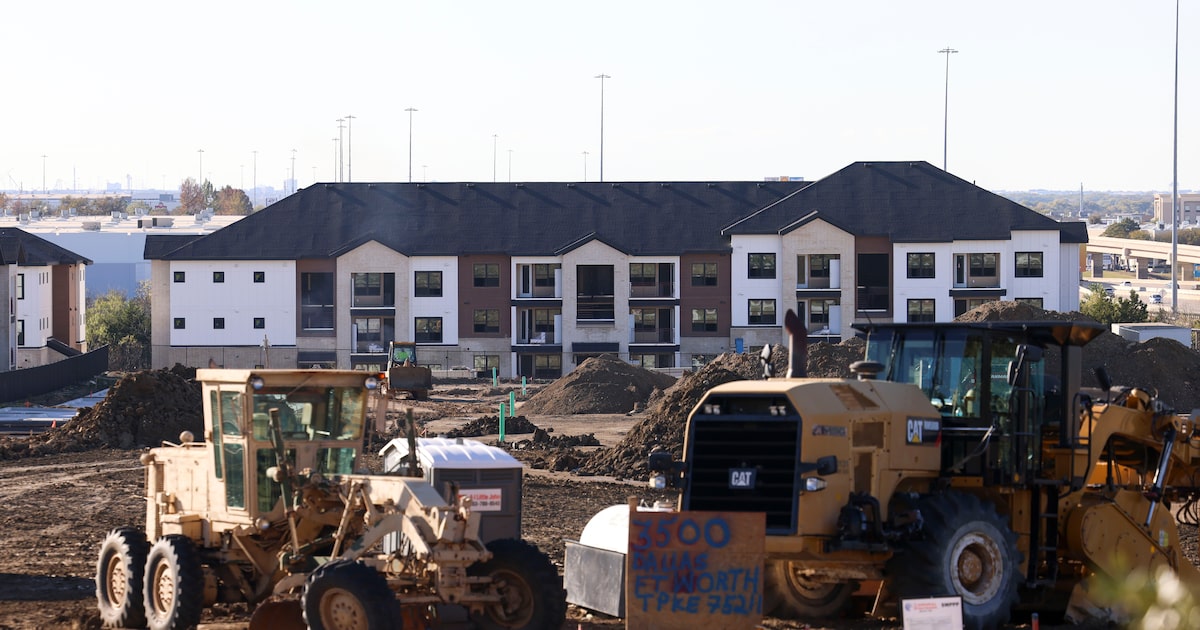Matt Bach gave up. There was nothing more to do.
He and his neighbors spent years fighting what became a $200 million plan to transform the aging Pepper Square shopping center in Far North Dallas into a mixed-use development with nearly 900 apartments.
The fight took them to the city plan commission, city council and eventually a Dallas County courtroom.
In late August, the white hot zoning war ended abruptly. And the final shot was fired not in North Texas — but from the halls of the Texas Capitol.
Bach and company voluntarily gave up their legal battle, citing a recently passed law intended to help address Texas’ housing shortage.
D-FW Real Estate News
SB 840, law of the land since Sept. 1, allows apartments and mixed-use residential in all zoning districts that allow office, commercial, retail or warehouse uses without a need for rezoning or special permits.
Huge swaths of land are affected by the state law, meaning aging office towers and retail strips may give way to multifamily towers.
“SB 840 is just kind of a sweeping sledgehammer approach to dealing with a problem that it frankly doesn’t solve,” he said. “It doesn’t provide affordable housing — maybe a small part. It’s just a developer’s dream for them to go in and not have to deal with local governments.”
The legislation applies only to the biggest cities in Texas’ largest counties, but more than half of the affected municipalities fall within the Dallas-Fort Worth metro area.
The Dallas Morning News spoke with residents, developers, financing experts, land use attorneys and others about the new law and how it might change North Texas.
Housing advocates argue cities must promote the creation of apartments for low-income residents where the housing shortage is felt most acutely.
In the short term, interest rates and other market forces make building apartments more difficult.
In the long term, the cranes may rise. Dallas has welcomed the new law, providing guidance to landowners for future projects.
Several outlying suburbs, however, have changed building codes, effectively making development more difficult in commercial areas.
The response could put them on a crash course with state leaders in Austin.
It’s Bach’s backyard — pockets of northern Dallas — where some of the most contentious zoning battles over apartments have been fought. Though none have been filed, residents have mulled legal challenges.
“None of the [developers] are bullish on this as a golden ticket to Willy Wonka’s chocolate factory,” said William Rosatti, a senior associate within Northmarq’s National Development Services group. “They all kind of understand that there’s major challenges. And unless it’s a city of Dallas site, we aren’t really advising any material change to land pricing unless we’ve heard that a particular city is clearly welcoming the policy change.”
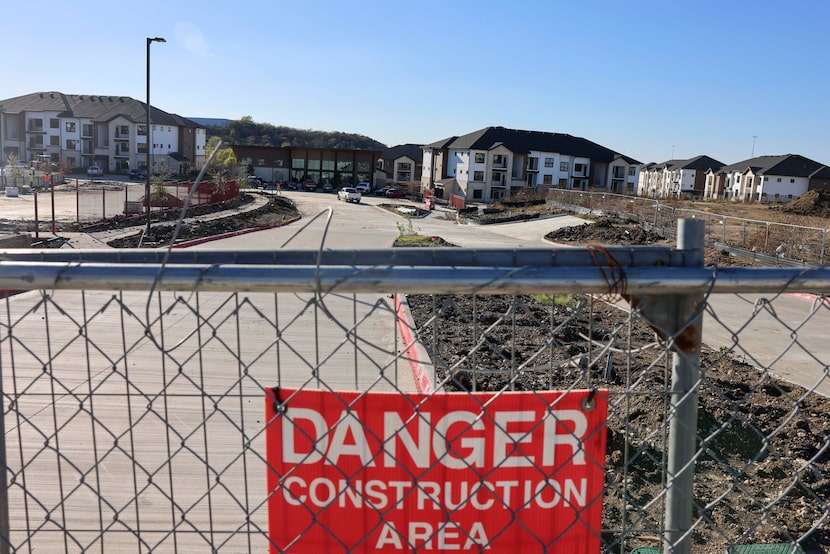
Construction zone of a new apartment complex by interstate 30, on Tuesday, Nov. 25, 2025 in Dallas.
Shafkat Anowar / Staff Photographer
SB 840
As more folks flock to D-FW and Texas, lawmakers at all levels have worked to build more housing.
In 2023, Texas was short 306,000 homes, according to an analysis by housing equity group Up for Growth.
The estimated housing deficit in D-FW hit 49,204 in 2023 — that’s the number of families “doubling up” by living with nonrelatives, minus the units available to buy or rent, according to the most recent data from Zillow.
Growth brings tension, and residents must reckon with the consequences of explosive growth. Dallas is no different.
The most contentious among them centered around ForwardDallas — the first update to the city’s land use plan in roughly two decades.
The biggest opposition came from homeowners who feared city leaders were plotting the death of single-family neighborhoods. They packed public meetings last year in Dallas’ libraries, rec centers and churches to decry the changes.
The Dallas City Council approved the plan meant to guide future development throughout the city by a vote of 11-4 after crafting amendments to protect the character of existing neighborhoods.
State lawmakers want to eat into the housing shortage, too. A slate of legislation with bipartisan support was approved, including SB 840.
SB 840 applies to any city with at least 150,000 residents within a county that has a population of at least 300,000. The law limits development regulations and streamlines the permitting process for these projects in zoning districts that allow office, commercial, retail or warehouse uses.
Of the nearly 20 cities affected, more than half are in Dallas-Fort Worth:
- Dallas
- Fort Worth
- Arlington
- Plano
- Irving
- Garland
- Frisco
- McKinney
- Grand Prairie
- Mesquite
Height limits for buildings are 45 feet or the tallest height allowed by the zoning code at the site, whichever is greater.
Density must be 36 units per acre or the highest density allowed in the municipality, whichever is greater.
Cities may not require setbacks greater than 25 feet or the largest setback required of a commercial building, whichever is smaller.
To convert an existing commercial building without a zoning change, the property has to be at least five years old. Developers won’t need to complete a traffic analysis under such a conversion.
Cities are prohibited from requiring parking at a ratio greater than 1 space per apartment. Projects also don’t need structured parking or nonresidential/retail uses.
The new law has the potential to change the makeup of the region.
An updated Child Poverty Action Lab analysis of zoning districts in Dallas County found 75,600 acres of commercially owned land were deemed “high potential” for the construction of housing. Much of the land is vacant.
Using only 25% of the parcels and building at 25% density, the firm estimates 328,000 new apartments could be built.
These projections are meant to be taken with a grain of salt. They don’t take into account the shovel-readiness of each parcel. Some lack needed infrastructure or are far from public transit and employment centers, the group said.
The analysis also doesn’t account for Dallas’ numerous Planned Development (PD) districts, which set specific zoning regulations for portions of the city.
While density would be unlimited in Dallas, height limits will differ between Planned Development districts. Thomas Mann, a land use attorney with Dallas-based Winstead PC, said there are more than 2,000 such districts in Dallas.
While not an actual impact analysis, the numbers give high-level estimates on the law’s potential impact in Dallas.
“There is a lot of opportunity that could be unlocked with SB 840,” said Ashley Flores, senior director at Child Poverty Action Lab, a Dallas nonprofit that tracks housing data and is dedicated to dramatically reducing childhood poverty. “The potential is enormous.”
That potential comes with its own set of challenges. At least half of the D-FW cities impacted by the law have already put up roadblocks, and residents have mulled their own legal challenges.
D-FW cities fight against new law
SB 840 became law Sept. 1.
In the lead-up and the months following passage, at least six D-FW cities have made changes to their building codes that effectively make it more difficult to build more apartments in these areas.
They are Arlington, Frisco, Grand Prairie, Irving, McKinney and Plano.
Each took a slightly different approach. Changes included height thresholds, stricter building codes, amenity requirements, design standards and infrastructure requirements.
For example, Irving upped its height requirements to eight floors. Developers must include a dog park, a gym, a swimming pool, a workspace for remote workers and pick from a handful of additional amenities for new developments.
Frisco took a more complicated approach that might allow the city to sidestep the law altogether. They created a new use within their zoning regulations — heavy industrial.
The use is now allowed in every commercial zone in the city if a special use permit is granted. However, the state law explicitly forbids apartments and mixed-use developments in zoning categories that also allow heavy industrial use or within 1,000 feet of an existing heavy industrial development site.
The city may argue that any commercial site has the potential to be a heavy industrial site. Representatives for the city declined to speak with The Dallas Morning News.
Garland is considering changes that would include raising the maximum height to 60 feet, but setting a minimum height of 40 feet to discourage two-story, garden-style apartments.
The city, like others in North Texas, would force developers to pick from a list of amenities that must be included in the project.
The cities argue the changes will help these new apartment projects fit with nearby developments.
“Even though the state has limited cities’ control, McKinney is taking steps to protect the character of the community. New rules will focus on building design so that apartments in business districts will be shaped and styled to fit better with nearby offices or retail,” the city said on its website explaining the new law. “These changes balance growth with livability and ensure new housing fits McKinney’s quality standards while staying compliant with state law.”
The changes effectively make projects more expensive. At certain heights, wood frame construction must become steel and concrete. Additional amenities means additional costs.
The local restrictions could motivate state lawmakers to make additional changes, Mann said.
“(People) think it’s going to be this flood of apartments, and that’s just not correct because of the local responses to it. We’re actually in a period … where apartment development is harder now than it was before the bill in many instances,” he said.

Traffic move along S. Buckner Blvd as a construction of an apartment complex is seen, on Tuesday, Nov. 25, 2025 in Dallas.
Shafkat Anowar / Staff Photographer
Other D-FW cities are embracing the changes
Dallas has shared information with developers to help them understand the new law and how it works.
Fort Worth passed a resolution affirming the city will comply with the law. City staffers are drafting amendments to the city’s Zoning Ordinance, and the council is expected to vote on the changes early next year.
“Dallas has been pushing for years to try and get more mixed-income housing development. I think they’ve taken the view that this law can be helpful in this endeavor,” Mann said.
Mann added that the local changes create an environment ripe for legal challenges.
“Any time the law changes this dramatically, there’s just going to be any number of scenarios that are unclear in how it’s going to be applied,” he said. “Then you couple that with all the local legislative changes that we’re made in response to it. Now, you’ve got a lot of new laws, both at the state and local levels, that were created in the last 60 days and arguably, conflict with each other in many ways.”
Under the new law, a housing organization or other adversely affected person may sue for declaratory or injunctive relief. The venue is where the project is located and appeals are handled by the Fifteenth Court of Appeals.
Major North Texas developers are keeping a close eye on SB 840 and how the bill might impact their work.
Centurion American Development Group CEO Mehrdad Moayedi is best known for his development of single-family neighborhoods across North Texas, but he has some mixed-use and apartment projects underway. His firm is nearly done with the Parc at Jackson, an apartment development in downtown Dallas.
It’s areas like downtown Dallas and other major corridors that will benefit most from the bill, he said.
“The ordinance is not going to affect much at all in the suburbs because those guys will fight it bad,” he said. “At the same time, when you’ve got this new building going on, it’s hard to [convert] an existing building — because it’s going to take $200 to $300 a square foot to convert. …It doesn’t work well unless you have a plan.”
David Craig, CEO of Craig International and master developer behind the $7 billion mixed-use Preston Harbor project at Lake Texoma, said the state will prevail over the suburbs in this dispute.
“The state will come back and say this is completely contrary to why we did what we did,” he said.
Will neighbors fight back?
Bach didn’t want to give up on Pepper Square, even after the passage of SB 840. They talked to groups about continuing the legal fight.
Money was the biggest impediment, but Bach is holding out hope someone challenges the law.
“We just knew there weren’t the resources to pursue that. Believe me, it was mulled over a lot, and a bitter pill to swallow,” he said. “We let it go just because of money.”
Residents seeking to challenge the new law might argue “inverse condemnation” — a legal concept used by property owners when a governmental entity destroys or acquires property without paying proper compensation, said Chuck Dannis, an SMU adjunct professor who has been a real estate appraiser and consultant since 1972.
“It sure sounds like an action by the government that affects you as a landowner that wasn’t anticipated. Now, whether all that’s illegal — who knows,” he said.
Mann, the land use attorney, said such a challenge on the validity of the law likely wouldn’t be successful.
“Most cities have zoning authority only because it’s given to them by state law,” he said. “What SB 840 did was it went into that zoning enabling statute and it amended it. It said [cities] still have zoning authority, but you can’t do these things.”
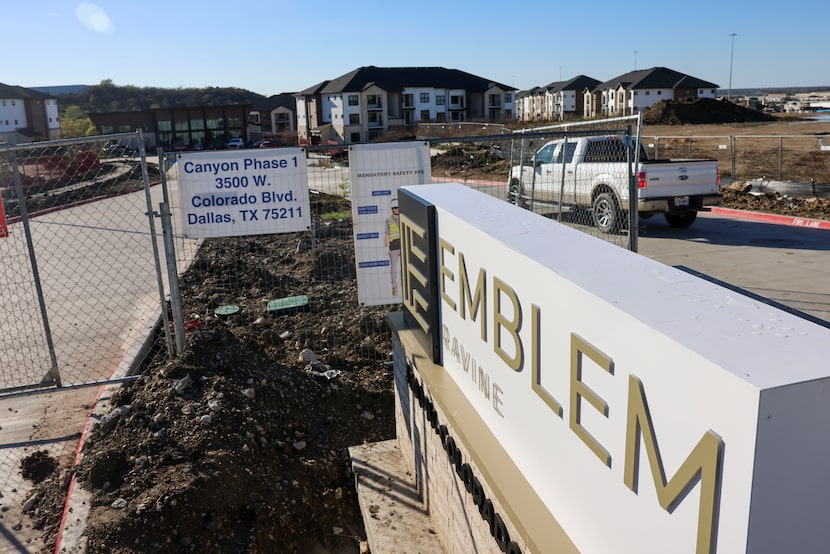
Construction zone of a new apartment complex by interstate 30, on Tuesday, Nov. 25, 2025 in Dallas.
Shafkat Anowar / Staff Photographer
Market challenges and the affordability issues
Even if D-FW cities fully embraced the new law, market conditions aren’t favorable for apartment developers right now.
Dallas has a temporary oversupply of apartments, fueled by a building boom as remote workers flocked to North Texas and other Sunbelt cities in the post-COVID years. Renters are still receiving concessions and other incentives.
A report from Colliers found construction continued to slow in the third quarter of 2025 and demand is down year over year. In D-FW, 43,521 apartment units are under construction — the 12th straight quarter of slowed building. Net absorption, the number of new units occupied minus the number of apartments vacated, was just over 5,000 during the quarter.
Data from Richardson-based RealPage show D-FW has offered among the highest share of rental concessions among the nation’s largest apartment markets.
As of August, 23.1% of all apartments in the Fort Worth-Arlington-Grapevine/Granbury market and 22% of all units in the Dallas-Plano-Irving submarkets were offering concessions to renters.
“The equity investor, the group that is putting up the money, is very cautious and focused on what the returns look like for the capital they’re investing,” said Brian O’ Boyle Jr., vice chairman of multifamily capital markets for Newmark.
Multiple apartment experts said fewer units are being started, and fewer units will come online from 2028 and beyond — a return to pre-pandemic production.
If market conditions were similar to those 2021, the legislation could turbocharge construction, experts said.
“I do think we will see an increased availability of housing related to the new bill, but you still have to have the economics make sense, and a challenge right now is just getting deals to pencil,” O’Boyle said.
Dallas is one of the nation’s top markets for apartment conversion projects. In 2024, North Texas added 698 apartments from adaptive reuse projects — the fourth-most in the nation, according to a study from Rentcafe.
Dallas has the country’s ninth-largest adaptive reuse pipeline with nearly 3,000 apartments in various stages of redevelopment. This is driven mainly by office-to-residential projects. Those make up 80% of the conversions, according to the study.
Not every vacant commercial building will be converted to apartments. The deal doesn’t always make sense.
New York developer Arthur Zeckendorf and his AZ Family Partners firms were the winning bidder for Preston Plaza — a mostly empty office tower sitting on one of Far North Dallas’ largest development sites.
The transaction is expected to close in the coming weeks, and Zeckendorf did not reveal how much his business bid for the site at 17950 Preston Road.
Commercial real estate firm Cushman & Wakefield served as the auction adviser and touted the site’s potential for a multifamily development under the new state law.
However, Zeckendorf won’t be building apartments here. He’s keeping it an office property and plans to spend $14 million on property improvements.
“Our specialty is residential. So we love doing apartments, but in this situation, we don’t think the economics work. We think this is a much better asset as an office,” he said. “We have no plans of making it residential. The office market in Dallas is probably performing the best of any office market.”
State lawmakers argue the new law, combined with other measures, would add to Texas’ housing supply and make housing more affordable.
Housing advocates say the new law may help address a shortage, but it may not help the region’s lowest-income renters.
The city of Dallas has a 46,000-unit gap in affordable rental housing. The shortage is expected to grow to 76,100 units by 2035, driven by a loss of over 54,000 unrestricted affordable housing units, according to data from the Child Poverty Action Lab.
Flores, who heads the Child Poverty Action Lab, said cities play a role in making sure more affordable housing gets built under the new zoning laws as well.
For example, publicly owned land could be converted to apartment developments, and cities could encourage public-private partnerships.
There are just over 32,000 acres of publicly owned land in Dallas County with high potential for conversion to housing, according to the nonprofit’s analysis.
“There’s an opportunity for cities to think really creatively about how they might pair SB 840 with other program incentives,” she said.
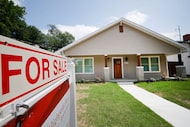 Roughly 87% of D-FW homes lost estimated value and other real estate news
Roughly 87% of D-FW homes lost estimated value and other real estate news
Here’s the latest real estate news from North Texas.
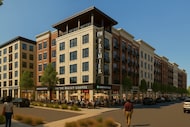 New $85 million mixed-use development coming to former Valley View mall
New $85 million mixed-use development coming to former Valley View mall
It’s the first project in the Dallas Midtown district, and it only takes up a small portion of the site.
